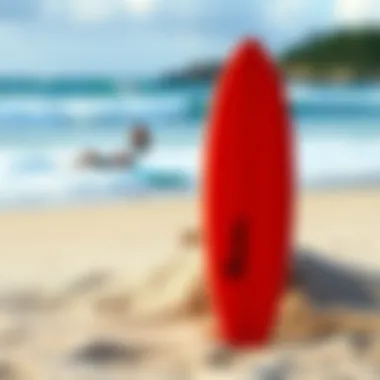Best Soft Top Surfboards for Beginner Surfers


Intro
Diving into the world of surfing can feel like a daunting experience for many newcomers. Selecting the right surfboard is an immeasurably important first step that guides your journey into the waves. Soft top surfboards stand as a beacon for beginners, providing a blend of safety, buoyancy, and ease of use. These features make them an excellent choice for those who are just starting. The soft foam surface acts as a cushion, easing the learning curve while helping newcomers gain confidence in the water.
In this guide, we will explore the intricacies of soft top surfboards. We will highlight their unique attributes that cater specifically to novice surfers, delve into the various options currently available in the market, and outline the vital factors to think about before settling on a purchase. Our aim is to equip newcomers with all the knowledge they need to make informed decisions and ride the waves with assurance.
Surf Gear and Equipment
In understanding how to navigate the surf, it’s paramount for beginners to be familiar with the right gear. Equipped with the correct surfboard can enhance your overall experience while ensuring safety in the water. Here’s what you need to know about current surfboard technologies and accessories that complement your surfing adventure.
Latest Surfboard Technologies
Soft top surfboards have evolved significantly over the years, integrating various technologies that improve performance and stability. Here are some advancements worth noting:
- EPS Core: Most soft tops come with an expanded polystyrene core that provides excellent buoyancy and lightweight characteristics, making paddling easier for beginners.
- Soft Foam Tops: The soft foam surface is not only gentle on the skin but also reduces the likelihood of injuries, allowing novices to hone their skills without the fear of hard impacts.
- Durability: Modern soft tops utilize advanced materials that withstand the wear and tear of salty water and rough handling, ensuring that your investment lasts longer.
These technological advancements contribute to a more forgiving surfing experience, making it easier for newcomers to learn the ropes and tackle their first waves.
Essential Accessories for Surfers
Getting started in surfing is not just about the board. Having the right accessories can significantly enrich your experience. Here are some essentials:
- Leashes: A reliable surfboard leash attaches to your ankle, preventing the board from drifting away after a wipeout.
- Board Bags: Protect your board from damage during transport with a quality board bag.
- Wax: Applying surfboard wax provides grip for your feet, reducing the chances of slipping while paddling or standing up.
- Rash Guards: Protect your skin from irritation due to sun exposure and board contact.
Being equipped with the right accessories, coupled with a soft top surfboard, sets a solid foundation for a successful surfing journey. It’s crucial to remember that well-chosen equipment can ease the process of learning, thereby enhancing your enjoyment in the surf.
"Choosing the right surfboard is more than merely a purchase; it's the beginning of a lifelong passion for riding waves and connecting with the ocean."
For further insights on surf gear, consider checking out Surfer Magazine or Surfing Waves for expert advice and trends in the surfing industry.
Understanding Soft Top Surfboards
When it comes to the early days of catching waves, the choice of surfboard is pivotal. Soft top surfboards stand out in today's surf scene, particularly for beginners who are just getting their feet wet, so to speak. With a range of features that promote safety and stability, these boards simplify the learning curve that can often feel steep for newcomers to the surfing world. In this section, we'll dive into the distinctive traits of soft tops and explore the advantages they bring to the table.
Definition and Features
Soft top surfboards, as the name suggests, are characterized by their soft, foam tops. This design is not just for looks; it plays a substantial role in enhancing the surfing experience for novices. Typically constructed with a foam deck and a hard underbelly, these boards also come equipped with rounded edges. The importance of this feature cannot be overstated—when falls happen (which they will!), the softer material significantly reduces the likelihood of injury.
Here are some key features that define soft top surfboards:
- Foam Deck: Provides comfort and safety, making it less intimidating for beginners to ride.
- Rounded Nose: Helps with buoyancy and forgiving the wipeouts.
- Stability in Size: Soft tops usually range from 8 to 9 feet, making them easier to balance on during paddling and riding.
- Lightweight Construction: This allows for easier handling both in and out of the water.
Soft tops are generally not just for progression; the novelty has led to increased popularity across diverse user groups, from groms to seasoned surfers who like to have fun with their riding.
Benefits of Choosing Soft Tops
Opting for a soft top surfboard comes with a plethora of benefits that make them ideal particularly for those starting their surfing journey. These advantages go beyond mere convenience and tap into the overall experience of learning to surf.
- Safety: The most significant draw is safety. An absence of hard materials means that the risk of injury during falls or collisions is markedly reduced. This is particularly advantageous for skateboarders or snowboarders transitioning to surfing; the soft foam is much less jarring.
- User-Friendly: Soft tops tend to be more stable on the water due to their buoyancy. This inherent stability is essential for someone still mastering balance, allowing them to remain upright more often.
- Easy Paddling: Beginners often face challenges with paddling out into the waves, but the lightweight nature of a soft top board helps in navigating the surf without undue stress. It’s true that beginners can get pretty tired, so anything to lessen that burden can really help.
- Affordability: Budding surfers needn’t break the bank to get started. Generally, soft top boards are priced lower than traditional hard tops, creating a compelling case for their use in learning.
In summation, soft top surfboards offer a compelling mix of safety, stability, and affordability, making them an attractive choice for anyone looking to ride the waves for the first time. By understanding these aspects, beginners can make informed decisions that will enhance their journey into surfing.
Why Beginners Should Opt for Soft Top Surfboards
When you're just starting your surfing journey, the choices can feel as overwhelming as a big wave crashing down on you. Among the myriad of options available, soft top surfboards stand out. They offer a perfect mix of user-friendliness, safety, and performance suited for newcomers. In this section, we’ll explore several reasons why beginners might want to put soft tops at the top of their list.
Safety and Stability
One of the driving reasons that soft tops have gained popularity among beginner surfers is their emphasis on safety. Traditional hard-top boards, while great in performance, can be unforgiving and risky for inexperienced riders. With softer materials, the risk of injury decreases significantly. Imagine you're out there paddling, and a wave catches you off guard. A soft top minimizes the severity of contact, whether it's from falling off the board or bumping into someone else.
Additionally, soft tops tend to have a wider and more stable shape compared to their hard counterparts. This added width helps new surfers easily maintain their balance on the board, even when they encounter sudden movements from the ocean. One might say it's akin to learning to ride a bike with training wheels – it makes a world of difference when you're just starting out.
Easier Paddle and Balance
Another key advantage of choosing a soft top surfboard lies in its design, which often focuses on ease of use. Soft tops are generally lighter than traditional boards, making them much easier to paddle. For novices still mastering their paddling technique, this can be a game changer. Less weight translates to less fatigue, allowing for longer sessions in the water.


Moreover, the softer foam construction also provides a better grip, enabling beginners to stand up and stay balanced more easily. Think of it like walking on sponge – the data shows that having something with a bit of give can really enhance your stability. By allowing fledgling surfers to focus on their technique, these boards can ultimately lead to improved skills over time.
Affordability and Accessibility
Surfing can quickly become an expensive hobby, but soft top surfboards help mitigate those costs significantly. Generally, they are offered at more accessible price points than traditional boards, making it easier for beginners to make an initial investment. After all, who wants to spend a fortune on a board before they've even mastered the basics?
In addition to that, many surf schools and rental shops prominently feature soft tops, meaning that before buying your own, you'll have the chance to test them out and figure out what works best for you. This accessibility helps empower new surfers, permitting them to dive into the sport without feeling financially strapped.
Moreover, as beginners realize they want to stick with surfing, they’re already familiar with the dynamics of soft tops, which can guide their future purchases. This is something to keep at the forefront: understanding the intricacies of these boards before stepping up to more advanced equipment can make a substantial difference to a novice's confidence and enjoyment.
Choosing a soft top surfboard can significantly increase a beginner's chances of success in the waves, enhancing both safety and fun.
Key Factors to Consider When Choosing a Soft Top Surfboard
When embarking on your surfing journey, choosing the right soft top surfboard isn't just a casual decision; it's a crucial stepping stone to success in the waves. Understanding the key factors that influence your choice can make a world of difference in your surfing experience, helping you evolve from a greenhorn to a wave-riding aficionado.
Size and Volume
Size and volume are intertwined factors that play a vital role in how a surfboard performs, particularly for beginners.
Why Size Matters:
- Stability: A larger board typically offers more stability, making it easier to balance and paddle. If you're just starting out, a board that’s about 8 to 10 feet is often recommended. The extra length helps prevent you from wiping out after every wave.
- Weight: Your personal weight should also influence your board size. Heavier surfers need greater volume to help stay afloat and maintain buoyancy.
Volume Considerations:
Volume is quantified in liters and dictates how much weight a board can support. The more volume in a board, the more weight it can support without sinking.
- A guideline for beginners: Aim for a surfboard with a higher volume; this helps new surfers catch waves more effortlessly. A soft top board with a volume that suits your weight will buoy you up, giving you the ability to ride waves instead of struggling underwater.
Material and Construction
The construction of a surfboard influences not just its durability but also its weight and buoyancy. Soft tops usually come in a few specific materials. Understanding these can aid you in making an informed choice.
- Foam Core: Most soft tops have a foam core, making them lightweight and buoyant. This is essential for beginners who need as much ease as possible.
- Epoxy and Polyurethane: While not all soft tops use these materials, they contribute to durability. Epoxy is tougher and prevents dings and scratches better than traditional poly. This means you can have a board that lasts a long time with minimal maintenance.
- Outer Layer: The outer soft foam layer protects against minor bumps and bruises that new surfers might encounter. It adds a layer of safety, ideal for learning.
Fin Setup and Performance
The fin setup of a soft top surfboard greatly determines how the board behaves in the water. A suitable fin configuration allows for diverse performance aspects, enhancing maneuverability and stability.
- Single Fin: A single fin setup is often stable and straightforward. It holds well in the water, which is excellent for beginners focusing on balance.
- Thruster Setup: This consists of three fins and is more versatile, giving an extra push and turning capability. It’s suitable for those who want to advance their skills quickly.
- Detachable Fins: Some boards allow for interchangeable fins, providing flexibility. This means you can adapt your setup as your skills improve, allowing a tailored experience.
Choosing the right surfboard is akin to tailoring a suit; it must fit you well in order to serve its purpose efficiently. Consider size and volume, pay attention to material and construction, and don't overlook the critical role of fin setups in your surfing journey. Each of these factors contributes uniquely to your learning curve, safety, and overall enjoyment as you engage with waves.
Top Soft Top Surfboards for Beginners
When it comes to taking the plunge into surfing, selecting the right board isn’t just a matter of preference. Soft top surfboards are often the go-to choice for newcomers, thanks to their unique design and user-friendly features. Unlike traditional hard boards, these soft tops offer a layer of foam that cushions falls and minimizes injury risk. This section provides a closer look at some top models available for beginners, emphasizing their importance and practicality.
Board One: Wavestorm '
Key Features
The Wavestorm 8' surfboard embodies simplicity with its notable EPS core, enabling excellent buoyancy. Its rounded nose design isn't just for looks; it enhances stability, making it a stand-out vessel for learning the ropes. The soft foam deck gives a grip that feels friendly underfoot, great for those clumsy first tries at standing up. Additionally, its light weight facilitates ease of transport, making it hassle-free to take to the beach.
Pros and Cons
One cannot overlook that the Wavestorm is easy to handle, particularly ideal for novices struggling with balance. However, it doesn't come without downsides. The softer material is prone to dings, and while it’s perfectly functional for lightweight riders, those looking for performance might find it lacking in speed. Remember, every decision has its balance, and this board showcases that dichotomy well for beginners.
Ideal For
The Wavestorm serves well for first-timers eager to catch their first waves in a forgiving environment. It’s especially suited for casual surfers who intend to navigate smaller, less powerful breaks. Given its reasonable price point, it stands out as a wise choice for youngsters or anyone just embarking on their surfing journey.
Board Two: Catch Surf Beater '"
Key Features
What sets the Catch Surf Beater apart is its versatility in waves. This board showcases a hybrid shape combining a fish tail and a traditional longboard style. The design not only pleases the eye but allows for maneuverability across varying surf conditions. Its dimensions create an overall volume that adds to its stability on the water, making paddling out easier for new surfers.


Pros and Cons
While the playful design and lightweight construction of the Beater makes it a fun board for small waves, it can feel a bit unstable in choppy conditions. The softer materials offer protection, but they do raise concerns about long-term durability if not handled properly. Despite some drawbacks, it’s an excellent starter board that doesn’t shy away from a bit of fun with smaller surf.
Ideal For
The Beater is perfect for those looking to stay active and escape the mundane. Ideal for riders who wish to transition from the whitewash to genuine surfing in a short time, this board accommodates both playful and practical riding. It makes for a reliable option for riders weighing under 200 pounds, always encouraging a little bit of adventure in every session.
Board Three: NSP Elements '
Key Features
The NSP Elements 7' surfboard emphasizes durability with a user-friendly design. Its epoxy construction not only keeps it lighter but also promotes longevity, reducing the risk of serious damage after a rough rigmarole with the waves. The board's design features an optimized rocker, allowing for easy paddling and smooth wave catching, making it even more beginner-friendly.
Pros and Cons
Backing this board are stand-out traits like great buoyancy and stability in the water. However, the price tends to be a factor for some. It's slightly pricier in comparison to others aimed at beginners, which might deter budget-conscious buyers. Families with growing surfers might find they can outgrow it quickly due to its lack of advanced performance features.
Ideal For
The NSP Elements is particularly suited for individuals ready to invest in a board that can take the rigors of surfing. Perfect for older, beginning surfers or families who frequent the waves and want a reliable vessel that won’t break the bank too early. A dependable option for those committed to a healthy lifestyle on the water.
Board Four: Odysea Log '
Key Features
Boasting a measured 9 feet in length, the Odysea Log provides ample area for novices getting their footing. Its expanded design offers a greater surface area, leading to reassuring stability for those just starting out. Equipped with a classic soft-top design, this board also provides lower drag through the water, which is a nice perk when it comes time to paddle out.
Pros and Cons
This board excels in paddling performance, allowing beginners to catch waves with relative ease. However, its size might pose challenges for those smaller in stature or strength. maneuvering it could feel like trying to steer a comfortable but unwieldy ship. Nevertheless, for those prepared to master its challenges, the rewards can be exhilarating.
Ideal For
The Odysea Log is especially advantageous for larger riders or those who plan to surf gentle, rolling waves on weekends. Particularly suited for beachgoers who want every step to feel secure, it's a cornerstone for families and everyone enjoying leisurely days by the sea.
Overall, exploring these options provides a great mix of choices that cater to varying skill levels and preferences for new surfers, ensuring their entry into the sport is met with comfort and excitement.
Comparative Analysis of Selected Models
When it comes to purchasing a surfboard, especially for beginners, a comparative analysis becomes a vital part of the decision-making process. This section aims to shed light on how evaluating selected models can empower novice surfers with the knowledge to make informed choices. Gathering data on various boards allows one to grasp their individual qualities, strengths, and weaknesses. It also helps understand which features cater best to the needs of emerging surfers, who may be overwhelmed by the sheer volume of options available. Ultimately, understanding the nuances of each board can align a surfer’s journey with the right equipment, fostering growth and enjoyment in the water.
Performance Metrics
Performance metrics are a crucial aspect when analyzing soft top surfboards. They include factors like stability, speed, maneuverability, and overall design. Each of these elements plays a significant role in how easily a beginner can learn to ride the waves. Stability, for instance, is fundamental; boards that offer a wider width often provide a more stable platform for standing, which lends confidence to those just starting out.
Moreover, the shape and volume of a surfboard affect not only how it catches waves, but also how it reacts to movements and turns. As such, metrics like volume, shape, and rocker are integral. Beginners should seek boards that excel in these areas, allowing for a smoother and more forgiving learning curve.
- Stability: Wider boards tend to offer better support, essential for beginners balancing on a moving surface.
- Speed: The board's ability to glide over water impacts the ease of catching waves.
- Maneuverability: Some boards are designed for turning and tricks, while others offer a straighter ride suitable for novice surfers.
“The right board allows you to navigate the waves with ease, shaping your confidence as a surfer.”
Price Points
The cost of soft top surfboards varies widely, and understanding price points is necessary for beginners who often have budget constraints. Generally, introductory models are affordable, with prices typically ranging from a few hundred to over a thousand dollars. Often, these options strike a balance between quality and cost, providing a solid platform for newcomers.
When comparing price points, it’s essential to keep in mind that higher-priced boards may come with advanced features or construction material that enhances durability and performance. However, some budget-friendly options perform admirably and serve their purpose effectively for the beginner phase.
- Budget Boards: Usually range from $200 - $500; great for first-time buyers.
- Mid-Range Boards: Priced between $500 - $800; offer better features for those serious about progress.
- Premium Boards: Starting at around $800; these typically come with advanced construction and technology suited for long-term use.
Finding the right balance between affordability and quality ensures that beginners don’t break the bank while getting their feet wet - literally!
User Feedback and Reviews


User feedback is the lifeblood of a well-rounded comparative analysis. Understanding real-life experiences helps pinpoint the pros and cons of various boards. Reading reviews from fellow surfers—especially those who started as beginners—can provide insights that aren’t always reflected in product specifications.
Daily surf communities on platforms like Reddit, Facebook, or specialized forums tend to offer candid opinions and personal stories about different soft top surfboards. Whether it is about initial usability, how well a board holds up over time, or the general sentiment of comfort and performance, these core user perspectives can guide novices through the maze of choices.
- Look for common themes in reviews:
- Praise for stability or ease of paddling is often a good sign.
- Criticisms regarding the overall durability or value can be red flags.
Navigating through the noise of marketing and hype, user feedback serves as invaluable data for any beginner making their first surfboard purchase.
Maintenance Tips for Soft Top Surfboards
Maintaining a soft top surfboard is crucial for both performance and longevity. These boards, while designed for durability, still require attention and care to keep them in good shape. Proper maintenance not only enhances your surfing experience but also protects your investment. Taking some time to understand how to care for your board can lead to smoother rides, improved safety, and a longer lifespan.
Regular Cleaning
Cleaning your board after a surf session is not just about aesthetics. Salt water, sand, and exposure to the sun can take a toll on the material and performance of your soft top surfboard. Here are some simple cleaning practices:
- Rinse with Fresh Water: After every session, give your board a good rinse with fresh water. This helps remove salt, sand, and any other debris that may have accumulated during your time in the water.
- Use a Soft Cloth: A gentle cloth can help you wipe down the surface without scratching it. Avoid using anything abrasive, as this can damage the soft surface.
- Spot Clean Stains: If there's anything stubborn on your board, use a mild soap and water solution. Gently scrub the area with a soft sponge or cloth. Make sure to rinse well to remove any soap residue.
By incorporating regular cleaning into your routine, not only are you extending the life of your board, but you’re also enhancing your performance and safety on the waves. A clean board can lead to better maneuverability and reduced drag, making it easier for beginners to paddle and catch waves.
Storage Recommendations
How and where you store your soft top surfboard can make a huge difference in its longevity. Improper storage can lead to warping, fading, or even damage, so consider these recommendations for keeping it in mint condition:
- Keep it Indoors: Whenever possible, store your surfboard indoors or in a shaded area. Sunlight can fade the colors and weaken the materials over time.
- Use a Board Bag: A padded board bag is ideal for protecting your surfboard during transport and storage. It helps absorb shocks and keeps it safe from scratches and dings.
- Lay it Flat or Stand it Up: When storing your board, avoid leaning it against a wall or another surface where it could warp. Instead, lay it flat or stand it up vertically. If standing it up, make sure it’s in a stable position.
By following these storage tips, you can preserve the structural integrity and appearance of your soft top surfboard, ensuring you’re always ready for your next adventure in the waves.
"Invest in your surfboard's care, and it will pay you back with countless rides and memories."
These maintenance practices are essential not only for the surfboard itself but also for the overall enjoyment of your surfing journey. Staying proactive in cleaning and smart storage can transform your experience on the water.
Common Misconceptions About Soft Top Surfboards
Many people, especially those stepping into the surf world for the first time, hold several misconceptions about soft top surfboards. These misunderstandings can lead to poor purchasing decisions or hesitation to embrace this user-friendly option. In this section, we'll clear the air around some of the most common myths that revolve around soft top boards, aiding beginners to make informed choices.
Durability Issues
One of the most frequent concerns surfboards beginners often voice is about the durability of soft tops. Perhaps you've heard someone express doubt, saying things like, “Aren’t soft tops just going to get trashed after a few wipeouts?” And while it’s true that soft top boards are constructed differently from their hard counterparts, they are not as fragile as some might think.
Soft top surfboards typically are made from closed-cell foam, which is designed to absorb impact. This foam is robust enough to withstand the occasional bumps and scrapes that come with learning. Unlike hard boards which may chip or dent, soft tops tend to be more forgiving.
“Certainly, the soft top will show wear over time, but that’s all part of the journey. Just like the surfers using them.”
Proper care, like keeping your board out of extreme temperatures and direct sunlight for extended periods, can further enhance its longevity. Regular inspections for any wear and tear can also help maintain its condition.
Performance Limitations
Another notion some folks cling to is that soft tops are inherently inferior when it comes to performance. You might hear the phrase, “Soft tops can’t ride waves like hard boards.” This idea, while widely accepted, is often exaggerated. While it’s true that soft tops may lack the speed and agility of a high-performance hardboard, they offer unique advantages that can be especially beneficial for beginners.
Soft tops provide a more stable platform that significantly aids with paddling and balancing. For newbies, having a board that allows them to focus more on cracking the basics is invaluable. As you progress, transitioning to a more performance-oriented hardboard can happen seamlessly with your improved skills.
Soft tops can handle various conditions like smaller beach breaks or mellow waves, offering a different style of enjoyment. Each type of surfboard has its purpose, and labeling soft tops merely as low-performance overlooks a wealth of experience that they provide.
Summary
Ultimately, separating fact from fiction helps new surfers tap into the advantages of soft top surfboards. Addressing these durability and performance misconceptions allows beginners to see that these boards can support their learning journey. When armed with the right information, newcomers can fully embrace their experience on the waves, navigating through the fears and doubts with confidence.
Epilogue
In wrapping up our discussion on soft top surfboards, it’s evident that these boards serve as an indispensable asset for beginners stepping into the world of surfing. The unique attributes of soft tops—such as their safety features, increased stability, and ease of handling—present a remarkable way for novice surfers to learn and enjoy the ocean. They not only encourage exploration of the sport but also foster a stronger connection to the waves without steep risks of injury often associated with hard-topped boards.
The affordability aspect of soft top surfboards further amplifies their appeal. Newer surfers can experiment with different styles and techniques without breaking the bank. It’s not just about being economical; it's an invitation to get out there and experience the thrill of riding waves, nurturing the passion that may very well turn into a lifelong hobby.
However, potential users should consider their specific needs as well. Different board shapes, sizes, and materials exist, and recognition of what suits one's surf style and goals is crucial. So, being informed about these factors can lead to a board choice that ensures proficiency and enjoyment.
As one delves deeper into surfing, the soft top surfboard can serve as a stepping stone to more advanced equipment as skills improve. Selecting the right soft top not only enhances the learning journey but also builds confidence to take on new challenges in the ocean.
"The waves are a teacher, and the surfboard is a bridge to understanding."















